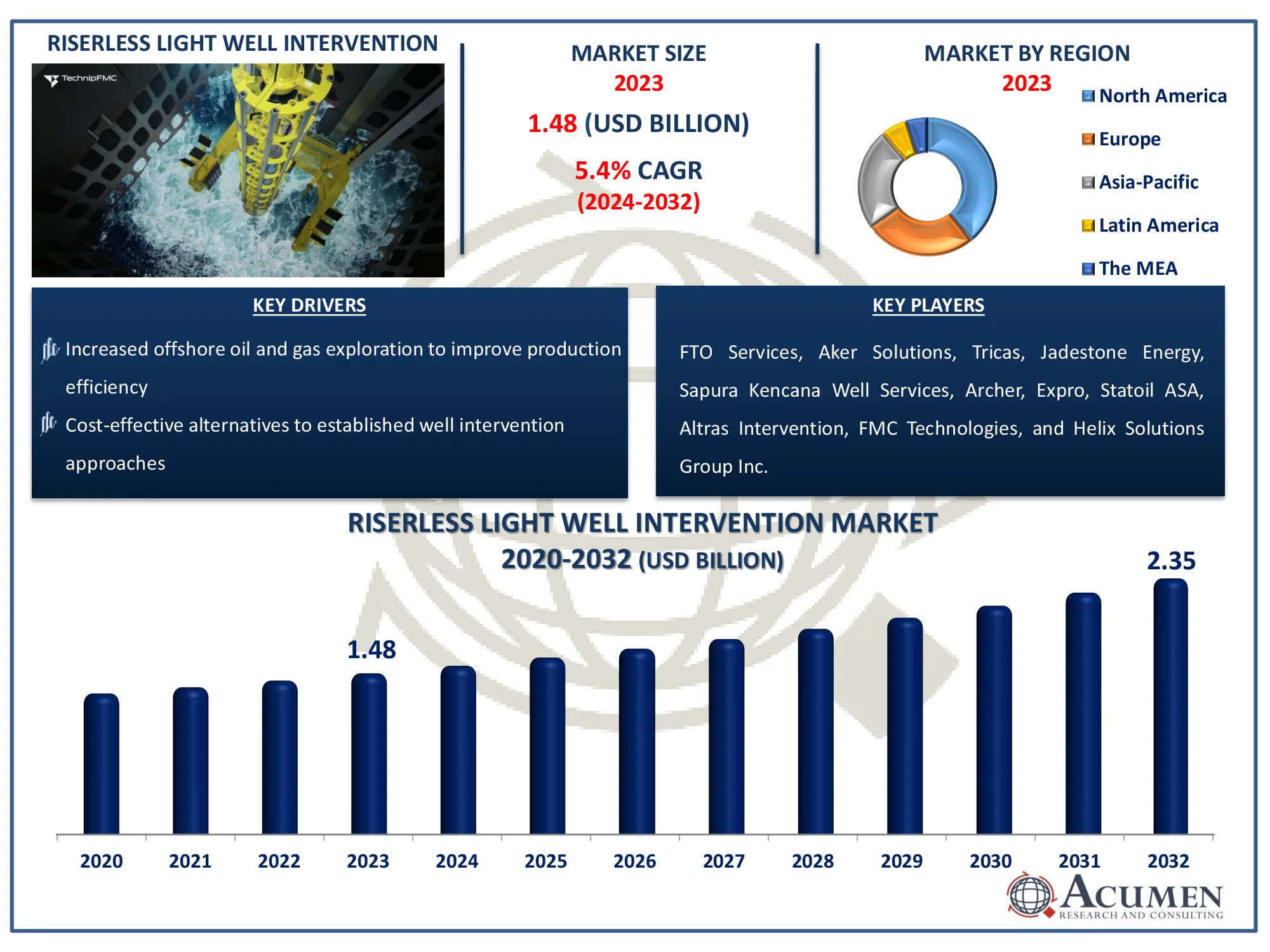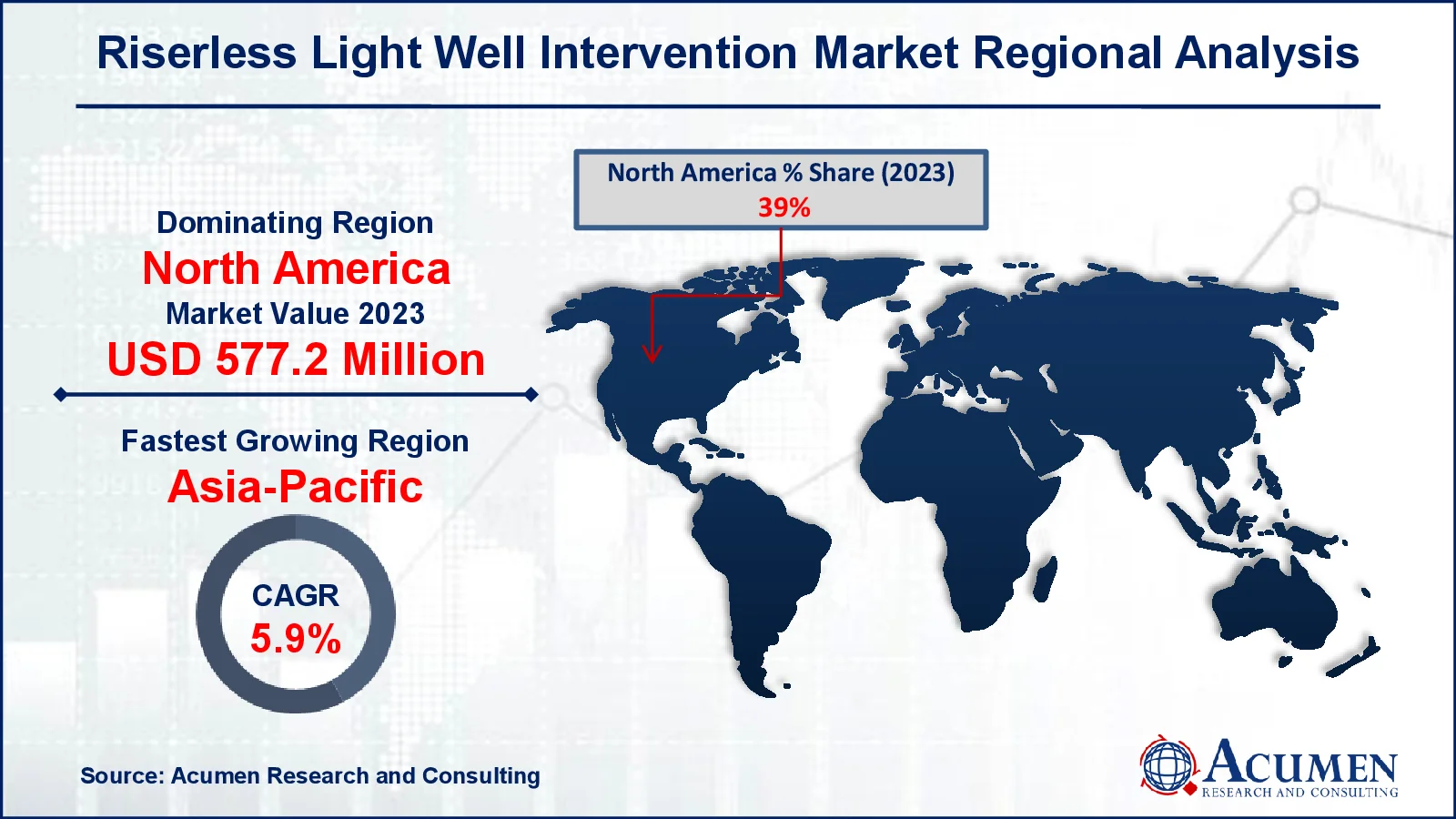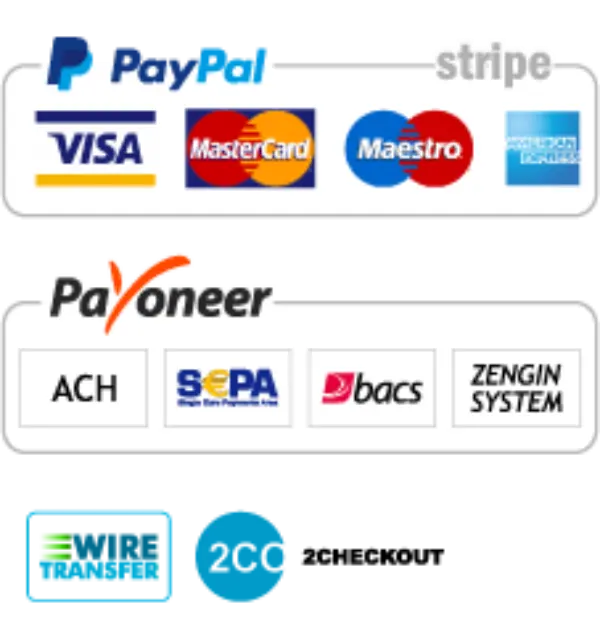Riserless Light Well Intervention Market Size - Global Industry, Share, Analysis, Trends and Forecast 2024 - 2032
Published :
Report ID:
Pages :
Format :
Riserless Light Well Intervention Market Size - Global Industry, Share, Analysis, Trends and Forecast 2024 - 2032
Report Coverage
- Industry Dynamics
- Market Size and Forecast Data
- Segment Analysis
- Competitive Landscape
- Regional Analysis with a Niche Focus on Country-Level Data
- High Level Analysis - Porter's, PESTEL, Value Chain, etc.
- Company Profiles of Key Players
- Option to Customize the Report As Per Your Specific Need
Request Sample Report
The Global Riserless Light Well Intervention Market Size accounted for USD 1.48 Billion in 2023 and is estimated to achieve a market size of USD 2.35 Billion by 2032 growing at a CAGR of 5.4% from 2024 to 2032.
Riserless Light Well Intervention Market Highlights
- Global riserless light well intervention market revenue is poised to garner USD 2.35 billion by 2032 with a CAGR of 5.4% from 2024 to 2032
- North America riserless light well intervention market value occupied around USD 577.2 million in 2023
- Asia-Pacific riserless light well intervention market growth will record a CAGR of more than 5.9% from 2024 to 2032
- Among type, the light intervention sub-segment generated noteworthy revenue in 2023
- Based on application, the offshore sub-segment generated significant riserless light well intervention market share in 2023
- Expanding adoption of sustainable energy practices in the oil and gas sector is a popular riserless light well intervention market trend that fuels the industry demand

Riserless light well intervention (RLWI) has become an essential part of maintaining subsea wells, especially as their numbers grow globally. These systems allow operators to carry out crucial tasks like repairing wells, isolating problematic zones, applying chemical treatments, and removing scale without the need for expensive rigs or riser systems. RLWI is a low-cost and effective method of accessing subsea wells that employs dynamically positioned vessels and remotely operated vehicles (ROVs).
What distinguishes RLWI is its ability to eliminate the traditional reliance on risers, which not only saves money but also accelerates operations. New technology, such as composite cables and enhanced well control systems, makes interventions safer and more precise. Historically, accessing subsea wells required significant infrastructure; however, RLWI changed the game by simplifying the process and allowing interventions to take place in previously difficult or expensive locations.
Finally, RLWI's value originates from its ability to reduce downtime, cut operating costs, and remove environmental risks all while ensuring the smooth operation of subsea wells. This is why it is gaining appeal in numerous areas and industries that rely on offshore energy generation.
Global Riserless Light Well Intervention Market Dynamics
Market Drivers
- Increased offshore oil and gas exploration to improve production efficiency
- Cost-effective alternatives to established well intervention approaches
- Advances in subsea technology improve operational reliability
- Growing demand for minimally invasive treatments in aging wells
Market Restraints
- A significant initial capital expenditure is required for riserless light well intervention systems
- Operational issues in extreme deepwater environments
- System operations have a limited number of trained people available
Market Opportunities
- Offshore exploration is growing in emerging regions such as Asia-Pacific and South America
- Increasing focus on decommissioning outdated offshore platforms
- Innovations in remotely operated vehicles (ROVs) for greater efficiency
Riserless Light Well Intervention Market Report Coverage
|
Market |
Riserless Light Well Intervention (RLIWI) Market |
|
Riserless Light Well Intervention Market Size 2023 |
USD 1.48 Billion |
|
Riserless Light Well Intervention Market Forecast 2032 |
USD 2.35 Billion |
|
Riserless Light Well Intervention Market CAGR During 2024 - 2032 |
5.4% |
|
Riserless Light Well Intervention Market Analysis Period |
2020 - 2032 |
|
Riserless Light Well Intervention Market Base Year |
2023 |
|
Riserless Light Well Intervention Market Forecast Data |
2024 - 2032 |
|
Segments Covered |
By Type, By Application, and By Geography |
|
Regional Scope |
North America, Europe, Asia Pacific, Latin America, and Middle East & Africa |
|
Key Companies Profiled |
FTO Services, Aker Solutions, Tricas, Jadestone Energy, Sapura Kencana Well Services, Archer, Expro, Statoil ASA, Altras Intervention, FMC Technologies, and, Helix Solutions Group Inc. |
|
Report Coverage |
Market Trends, Drivers, Restraints, Competitive Analysis, Player Profiling, Covid-19 Analysis, Regulation Analysis |
Riserless Light Well Intervention Market Insights
Reduction in the cost of operation is considered to be the chief factor driving the growth of the RLWI market. These kinds of technologies help in processing cost-efficient performance into already existing subsea wells, hence resulting in surplus production volumes through the mature subsea fields at extraordinarily competitive costs. The conversion of drilling rigs to light monohulls through the work of well intervention reduces the cost of well intervention drastically, thus enabling the mega intervention work and gradually increasing recovery of oil. Further, the long-term agreement between service providers and operators has facilitated long-term alliances in RLWI services.
Conventional well operations are less costly than the drilling rigs for the utilization of intervention operations in subsea wells. Hence, well interventions like PLTs are not accomplished as required from the gathering of data points with less reservoir understanding. Therefore, the latest riserless light well intervention alliance comprises a strong basis for lowering the price. However, amalgamation of new technologies with traditional technologies can restrain the market growth. Nonetheless, rapid industrialization is anticipated to generate huge opportunities for the RLWI market.
Riserless Light Well Intervention Market Segmentation
The worldwide market for riserless light well intervention is split based on type, application, and geography.
Riserless Light Well Intervention RLWI Market By Type
- Medium Intervention
- Heavy Intervention
- Light Intervention
According to riserless light well intervention industry analysis, the market is divided into three segments light, medium, and heavy intervention. The light intervention segment is expected to hold the biggest market share. Light intervention operations are distinguished by their relative simplicity and often include duties such as wellhead maintenance, simple diagnostics, and modest repairs. This segment's dominance can be attributable to a number of factors, including its lower cost when compared to medium and heavy interventions. Furthermore, the growing demand for efficient and cost-effective subsea well control solutions is driving the expansion of the light intervention category.
Riserless Light Well Intervention RLWI Market Application
- Onshore
- Offshore
The market operates in both onshore and offshore locations. Both categories play an important role, but the offshore segment is expected to dominate the market. This dominance arises from the inherent obstacles and complexities of offshore operations. Offshore facilities, particularly those in deep water, necessitate specialized and often more costly intervention procedures. Riserless light well intervention is a low-cost and efficient way to address maintenance, repair, and production optimization requirements in these tough situations. Furthermore, rising exploration and production in deepwater and ultra-deepwater locations are expected to boost demand for riserless light well intervention services in the offshore market.
Riserless Light Well Intervention Market Regional Outlook
North America
- U.S.
- Canada
Europe
- U.K.
- Germany
- France
- Spain
- Rest of Europe
Asia-Pacific
- India
- Japan
- China
- Australia
- South Korea
- Rest of Asia-Pacific
Latin America
- Brazil
- Mexico
- Rest of LATAM
The Middle East & Africa
- South Africa
- GCC Countries
- Rest of the Middle East & Africa (ME&A)

Riserless Light Well Intervention Market Regional Analysis
The riserless light well intervention (RLWI) market varies significantly by area, both in terms of size and growth potential. North America now maintains the highest market share, owing to the region's established offshore oil and gas activities and a significant emphasis on technological advances in subsea intervention techniques. The region's mature oil and gas infrastructure provide an ideal setting for the deployment of riserless light well intervention technologies, which contributes to its market dominance.
In addition, the Asia-Pacific region is expected to the fastest growth in the riserless light well intervention market forecast period. This quick development can be attributable to a number of sources, including significant investments in offshore exploration and production, particularly in China, India, and Australia. The region's expanding energy demand, combined with the development of new offshore fields, is creating a favorable climate for the utilization of cost-effective and efficient intervention technologies such as riserless light well intervention.
Furthermore, the Asia-Pacific region is seeing substantial advances in subsea technologies, with a greater emphasis on research and development in areas such as robotics, automation, and remote operations. These technological improvements are likely to increase the efficiency and efficacy of riserless light well intervention operations, driving regional market expansion.
Riserless Light Well Intervention Market Players
Some of the top riserless light well intervention companies offered in our report includes FTO Services, Aker Solutions, Tricas, Jadestone Energy, Sapura Kencana Well Services, Archer, Expro, Statoil ASA, Altras Intervention, FMC Technologies, and Helix Solutions Group Inc.
Frequently Asked Questions
How big is the riserless light well intervention market?
The riserless light well intervention market size was valued at USD 1.48 Billion in 2023.
What is the CAGR of the global riserless light well intervention market from 2024 to 2032?
The CAGR of riserless light well intervention is 5.4% during the analysis period of 2024 to 2032.
Which are the key players in the riserless light well intervention market?
The key players operating in the global market are including FTO Services, Aker Solutions, Tricas, Jadestone Energy, Sapura Kencana Well Services, Archer, Expro, Statoil ASA, Altras Intervention, FMC Technologies, and Helix Solutions Group Inc.
Which region dominated the global riserless light well intervention market share?
North America held the dominating position in riserless light well intervention industry during the analysis period of 2024 to 2032.
Which region registered fastest CAGR from 2024 to 2032?
Asia-Pacific region exhibited fastest growing CAGR for market of riserless light well intervention during the analysis period of 2024 to 2032.
What are the current trends and dynamics in the global riserless light well intervention industry?
The current trends and dynamics in the riserless light well intervention industry include increased offshore oil and gas exploration to improve production efficiency, and cost-effective alternatives to established well intervention approaches.
Which application held the maximum share in 2023?
The offshore application held the maximum share of the riserless light well intervention industry.



